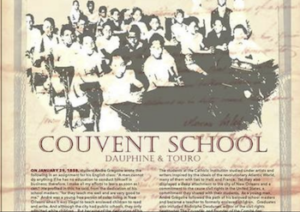
*On this date in 1837, the Institute Catholique was envisioned by Bequeath.
Also known as Ecole Des Orphelins Indigents (Catholic School for Indigent Orphans) and the Couvent School, it was a school founded in the Faubourg Marigny district of New Orleans. It was dedicated to providing free education to Black orphans, the first school in the United States to do so. It also served the non-orphan children of free people of color, who paid modest tuition. It operated as a distinct entity until 1915.
The school was financed from a trust established in the will of Madame Marie Couvent, the Black African widow of Bernard Couvent, one of the most commercially successful free men of color in New Orleans. The concept of educating Blacks was opposed by some of the white community in New Orleans, and the establishment of the trust for the school was challenged in court. The widow died in 1837, and when the original executor of the will failed to implement its terms forcefully, a group of ten leading Afro-Creole intellectuals residing in New Orleans formed The Catholic Institute for the Instruction of Indigent Orphans.
This group successfully sued in court to obtain control of the widow's estate. The courts did not finally rule in favor of this group until 1846. The charter authorizing the Institute Catholique to function as a corporation was received from the state of Louisiana in 1847, and the school opened in 1848, renting facilities in the Faubourg Marigny suburb just east of the French Quarter while awaiting construction of a permanent building on the land donated by Madame Couvent. Felice Coulon Cailloux, the wife of soldier Andre Cailloux, initially served as the school's principal while it operated in temporary quarters. By 1850, New Orleans had a population of approximately 150,000. Of this population, 15,000 were free people of color, and 15,000 were slaves. The city had a three-tier social structure, at the top of which were free whites, in the middle were free people of color, and at the bottom were slaves.
Free people of color could own property, own businesses, and enter contracts but could not vote, marry whites, or send their children to the city's public schools, established in 1841. This rankled the French-inspired republican idealism of the Afro-Creole intelligentsia, many of whom had been educated in France. The permanent building of the Institute Catholique was completed in 1852. The Afro-Creole poet Armand Lanusse, editor and contributor to Les Cenelles, a book of French poetry written by Afro-Creoles, who had been instrumental in founding the school and was one of the ten original Board Members, was named headmaster in 1852. He continued in that capacity until he died in 1867.
The Cailloux family were active supporters of the school throughout the 1850s, sending all three of their surviving children there for instruction. Felicie continued to work at the Institute for several years after Lanusse became headmaster and was responsible for the well-being of the 75 young orphan girls who attended. Though the school's property and building were provided for in the will of Madame Couvent, the income generated from the real estate included in her estate was insufficient to cover annual operating expenses.
The gap was made up through charitable contributions from several mutual aid societies established within the gens de couleur Afro-Creole community of New Orleans. The Friends of Order, an Afro-Creole mutual aid society of which Cailloux was a member, organized an annual contribution collected by its members at the cemeteries of New Orleans each year on All Soul's Day. Other mutual aid societies held annual charity balls. Occasionally, the school received small appropriations from the City of New Orleans and the State of Louisiana. The average annual enrollment during the 1850s was approximately 300.
The school continued in operation after the American Civil War. In 1866, Harper's New Monthly Magazine contained a positive story about the school, its teachers, and its students. During this period, the Institute Catholique maintained its position as the intellectual center of the Afro-Creole community of New Orleans. All faculty members were Afro-Creoles, many of whom were educated in France. Paul Trevigne, the editor of the French language Afro-Creole newspaper L'Union, a publication that advocated abolition and complete equality for blacks and the first black-owned and operated newspaper in the American South, was a teacher there for 40 years. In 1893, when Afro-Creole philanthropist Thomy LaFon died, he left a bequest to the school in his will to construct a new building. In 1915, that school was destroyed by a hurricane.
Lacking funds to rebuild, the Board of the Institute Catholique agreed to terms proposed by Sister Katharine Drexel, founder of Xavier University. She offered to build and operate a new school on the site, under the name St. Louis School of Holy Redeemer parish, on the condition that the Sisters of the Holy Ghost would operate it.
At the same time, a church, the Holy Redeemer Church, was built in the neighborhood, and the school, commonly referred to as Holy Redeemer, operated and staffed by Blacks, ceased to exist. Ernest "Dutch" Morial, the first Black Mayor of New Orleans, attended Holy Redeemer Elementary School during this period. In 1965 Hurricane Betsy destroyed the Holy Redeemer Church, but the Holy Redeemer Elementary School continued to operate. The school continued operation until 1993, when it closed due to a lack of funds. That same year, the Bishop Perry Middle School for Boys, a free school operated by the Roman Catholic Church's Society of St. Edmund, opened on the site. The school served 6th, 7th, and 8th-grade students of black heritage. Enrollment then ranged from 60 to 200 students.
Bishop Perry was forced to shut down its operations in August 2006, a victim of the economic losses of Hurricane Katrina. In addition, some of the families did not return to New Orleans after the evacuation caused by the Hurricane’s flooding. The building did not suffer great damage from the storm and subsequent flooding. In October 2006, the building became home to the St. Gerard Majella Alternative School. Operated by the Society of the Sisters of Notre Dame, this alternative school is designed to provide ongoing education to women of high school age who are pregnant. From its founding in 1846 until today, the school and its successors have been located at 1941 Dauphine Street in New Orleans. Four buildings have been located on the lot. The building is owned by the Diocese of New Orleans and was rented from the Diocese by the Society of St. Edmund during the 12 years it operated Bishop Perry Middle School.
